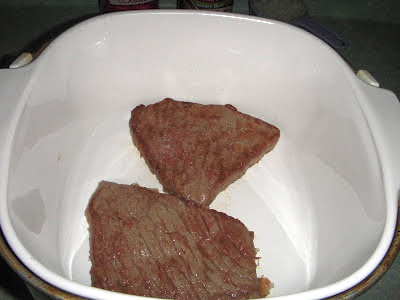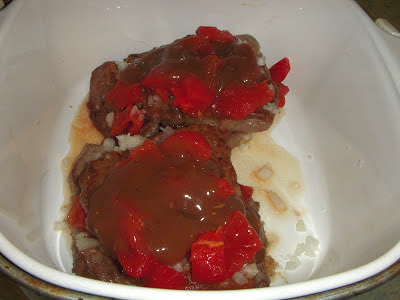I love cooking with a slow cooker -- or what my family refers to by the trademark name -- crock-pot. I use a crock-pot for appetizers, chili, sauces, stews, entrees, entire meals and even a sandwich. Some of the recipes were specifically for the crock-pot but others, like the one I'm sharing today, I adapted from the oven to the crock-pot.
My husband loved eating at my mother's house. One of the entrees she cooked that he really enjoyed was round steak smothered with onions, tomatoes and seasonings and baked a couple of hours until tender. That entree -- Swiss Steak -- was never one of my favorites. My mother used a lot more tomatoes and onions than I liked, plus she only added water to the ingredients which made for a flavorless gravy. Shortly after we got married, my husband asked if I would make Swiss Steak for supper sometime. I told him I would, but I'd need to find a recipe first.
I don't remember where I found it, but my husband deemed the first Swiss Steak recipe I tried a keeper and I've been cooking it ever since. The recipe was actually very similar to my mother's recipe. The round steak was pounded, coated with flour and browned in a skillet, but it used fewer tomatoes and onions and, instead of water, a jar of beef gravy. For years, I cooked it in the oven but, on a particularly hectic day, discovered it was equally delicious cooked in a crock-pot.
One day in the late 1990s, I realized I had a late afternoon appointment the same day I'd planned to cook Swiss Steak for supper. The meat had been thawing in the refrigerator for two days so it had to be cooked that day. I could fix the Swiss Steak according to the recipe which would make for a very late supper, or I could try cooking it in the crock-pot. Suppertime is always a stressful time of day for me even under the best of circumstances, so I opted for the latter.
Since crock-pot cooking is different from cooking in an oven, I had to make a few changes to the recipe.
- I don't pound the meat because low and slow cooking in the crock-pot tenderizes even the toughest cut of meat.
- The first couple of years, I skipped browning the meat because I'd read it was an unnecessary step in crock-pot cooking. One day, on a whim, I decided to see what would happen if I browned the meat first. I don't think browning the meat improved the flavor, but I think it made the finished product prettier. If I have time to brown the meat, I do; if not, I don't. It's delicious either way.
- When I cook Swiss Steak in the oven, my baking pan is big enough to hold the ingredients in one layer. Due to the size and shape of my crock-pot, I have to layer the ingredients. To compensate for that, I put some tomatoes, onions and gravy over each layer, instead of putting everything on the top layer.
Two layers of ingredients.
Cooking Swiss Steak in the crock-pot takes longer, but it makes suppertime so much easier for me. All that's left for me to do is fix a couple of sides -- baked potatoes and steamed broccoli in the winter and fresh corn-on-the-cob and a salad in the summer -- and supper is ready.
January might be National Slow Cooking Month, but crock-pots are wonderful to use all year long. After all, what's better than coming home to a hot cooked meal any month of the year?
Swiss Steak
4 to 6 Servings
1 (2 lb.) round steak, cut into 8 pieces
1/2 cup flour
1 tsp. salt
1/4 tsp. pepper
1/4 cup vegetable oil*
1/2 cup finely chopped onion
1 (14 1/2 oz.) can diced tomatoes
1 (12 oz.) jar beef gravy
Mix flour, salt and pepper in a large resealable plastic bag. Add meat, two pieces at a time, tossing to coat thoroughly. Heat oil in a large skillet. Add meat and cook one minute; turn meat over and cook the other side for one minute. Put a layer of meat in the crock-pot; put some onion, tomatoes and gravy over meat. Continue layering until all ingredients are used, ending with gravy. Cover and cook on low for 8 hours.
*If you don't brown the meat first, omit the oil and proceed as directed.
© Margaret's Morsels








